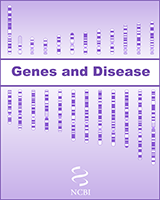NCBI Bookshelf. A service of the National Library of Medicine, National Institutes of Health.
National Center for Biotechnology Information (US). Genes and Disease [Internet]. Bethesda (MD): National Center for Biotechnology Information (US); 1998-.

Lesch-Nyhan syndrome (LNS) is a rare inherited disease that disrupts the metabolism of the raw material of genes.
These raw materials are called purines, and they are an essential part of DNA and RNA. The body can either make purines (de novo synthesis) or recycle them (the resalvage pathway). Many enzymes are involved in these pathways. When one of these enzymes is missing, a wide range of problems can occur.
In LNS, there is a mutation in the HPRT1 gene located on the X chromosome. The product of the normal gene is the enzyme hypoxanthine-guanine phosphoribosyltransferase, which speeds up the recycling of purines from broken down DNA and RNA. Many different types of mutations affect this gene, and the result is a very low level of the enzyme.
The mutation is inherited in an X-linked fashion. Females who inherit one copy of the mutation are not affected because they have two copies of the X chromosome (XX). Males are severely affected because they only have one X chromosome (XY), and therefore their only copy of the HPRT1 gene is mutated.
Mutations of the HPRT1 gene cause three main problems. First is the accumulation of uric acid that normally would have been recycled into purines. Excess uric acid forms painful deposits in the skin (gout) and in the kidney and bladder (urate stones). The second problem is self-mutilation. Affected individuals have to be restrained from biting their fingers and tongues. Finally, there is mental retardation and severe muscle weakness.
In the year 2000 it was shown that the genetic deficiency in LNS could be corrected in vitro. A virus was used to insert a normal copy of the HPRT1 gene into deficient human cells. Such techniques used in gene therapy may one day provide a cure for this disease. For now, medications are used to decrease the levels of uric acid.
- Genome view see gene locations
- Entrez Gene collection of gene-related information
- BLink related sequences in different organisms
- Research articles online full text
- Books online books section
- OMIM catalog of human genes and disorders
- GeneReviews a medical genetics resource
- Fact sheetfrom National Institute of Neurological Disorders and Stroke, NIH
- Lesch-Nyhan syndrome - Genes and DiseaseLesch-Nyhan syndrome - Genes and Disease
Your browsing activity is empty.
Activity recording is turned off.
See more...
